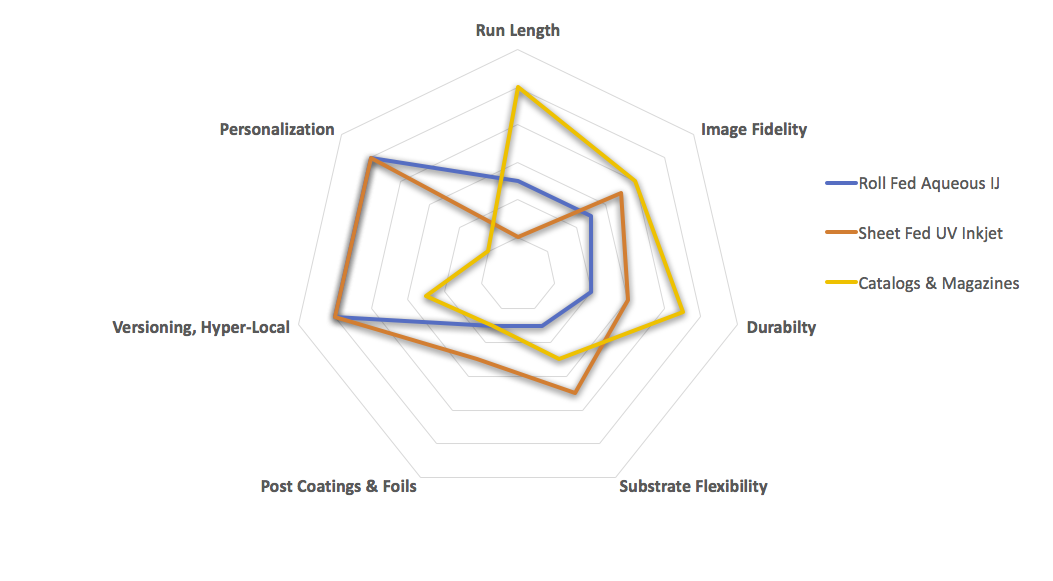Print volume for magazines and catalogs rivals what is produced for marketing collateral, however the penetration of digital printing is much lower. The main barriers are run lengths, productivity, cost, and to a lesser extent, print quality. It’s important to note that much of the market is off limits to digital printing today. We did a quick calculation of a 96-page magazine with a circulation of 2.5 million and determined it would take 1.5 ultra-high-speed inkjet presses a full month to print the publication. It would take 30 presses to produce the same publication in 24 hours. It’s a similar story for catalogs where some are reaching volumes that would require a fleet larger than all of the inkjet presses installed in the world to date. Imagine producing 210 million 300-page Ikea catalogs on an inkjet press.
This isn’t intended to discourage anyone, but it should put things in perspective and help focus the actual opportunity for inkjet printing. There are over 7,000 magazine titles and the overwhelming majority have circulations well below 1,000,000. The same is true for catalogs. This is where inkjet entrepreneurs should start looking at how to transition customers from offset. Inkjet can play a role in producing short runs for small circulations, enabling versioning, hyper-localization, and personalization. For example, inkjet may not be right for the majority of Ikea’s catalog volume, but perhaps there are opportunities for localized versions for smaller markets, or to use inkjet to produce a personalized component that is incorporated in the traditionally printed catalog. It must make economic sense as offset often has a cost advantage for high volume work. Finding the sweet spot is critical to success.
There are a number of drivers for print providers to offer inkjet printing for catalogs and magazines:
- Opportunity and competition for untapped analog pages
- Secure contractual and recurring print volume
- Monetize value-added services to increase the effectiveness of print
So, let’s talk about the printing requirements to help transition both analog catalog and magazine pages to inkjet printing.
Currently the print quality expectations for magazines and catalogs are quite high. These requirements include exact color matching for product color confirmation, as well as brand identity. In addition to a high level of color fidelity is image sharpness. Inkjet’s error diffusion screening lends itself to be grainer than traditional offset rosette. Also, unlike offset, inkjet depends on the resolution per inch of the print head. Photos and regions of interest must maintain a minimum image size, calculated relative to the print head resolution, to ensure sharpness.
Magazine and Catalog applications require thinner paper grammage than most of the printing industry. Papers used are commonly in the range of 60 to 75 gsm or 40# to 60# text weight. Thinner papers normally do not play well with high TAC levels of aqueous ink. TAC/TIC (total area coverage/total ink coverage) must be managed carefully at the lower levels of the spectrum. Offset can manage TAC levels in the 240 percent range, but inkjet with an aqueous carrier is limited to 180 to a 220 percent depending on the paper grammage. Managing a thin layer of ink is important for both drying and to keep the paper from curling or cockling, which can cause trim, folding and inserting issues.
Offset printing satisfies the majority of the production requirements for both catalogs and magazines. As marketers seek to increase ROI, you can start to make the case for shorter runs, versioning, hyper-localization, and personalization – and then inkjet printing starts to become interesting. The first chart bellow compares the requirements for catalogs and magazines to the capability of offset printing. The second chart bellow compares the applications to inkjet printing and illustrates that there are opportunities. We’d like to hear your thoughts on the opportunity for inkjet in these applications. Is there a compelling need for inkjet? What’s working? What is needed to accelerate adoption? I’d love to hear from you.
Comparative Technology Analysis – Incumbent Technology
Values are based on average capabilities of offset presses on the market.

Comparative Technology Analysis – Inkjet Technology
Values are based on average capabilities of aqueous pigment devices on the market.

